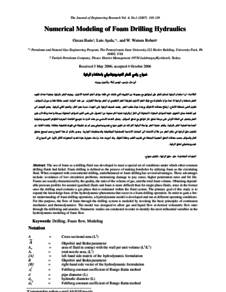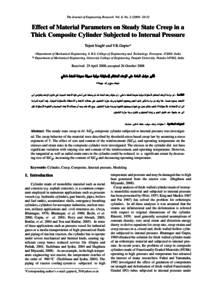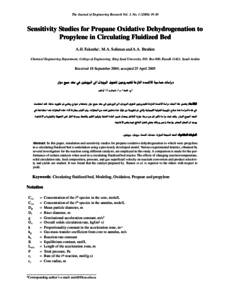وثيقة
Numerical modeling of foam drilling hydraulics.
المساهمون
Ayala, Luis, مؤلف
Robert, W. Watson, مؤلف
الناشر
Sultan Qaboos University
ميلادي
2007
اللغة
الأنجليزية
الملخص الإنجليزي
The use of foam as a drilling fluid was developed to meet a special set of conditions under which other common drilling fluids had failed. Foam drilling is defined as the process of making boreholes by utilizing foam as the circulating fluid. When compared with conventional drilling, underbalanced or foam drilling has several advantages. These advantages include: avoidance of lost circulation problems, minimizing damage to pay zones, higher penetration rates and bit life. Foams are usually characterized by the quality, the ratio of the volume of gas, and the total foam volume. Obtaining dependable pressure profiles for aerated (gasified) fluids and foam is more difficult than for single phase fluids, since in the former ones the drilling mud contains a gas phase that is entrained within the fluid system. The primary goal of this study is to expand the knowledge-base of the hydrodynamic phenomena that occur in a foam drilling operation. In order to gain a better understanding of foam drilling operations, a hydrodynamic model is developed and run at different operating conditions. For this purpose, the flow of foam through the drilling system is modeled by invoking the basic principles of continuum mechanics and thermodynamics. The model was designed to allow gas and liquid flow at desired volumetric flow rates through the drillstring and annulus. Parametric studies are conducted in order to identify the most influential variables in the hydrodynamic modeling of foam flow.
المجموعة
ISSN
1726-6742
URL المصدر
zcustom_txt_2
Baris, O., Ayala, L., & Robert, W. W. (2007). Numerical modeling of foam drilling hydraulics. The Journal of Engineering Research, 4 (1), 103-119.
الملخص العربي
إن استخدام الرغوة كسائل للحفر طور ليتوافق مع مجموعة من الظروف التي فشلت في ظلها سوائل الحفر العادية الأخرى. ويعرف الحفر بالرغوة بعملية أحداث ثقوب الحفر باستخدام الرغوة له عدة مزايا بالمقارنة مع طرق الحفر الأخرى كطريقة الحفر التقليدي أو الحفر بواسطة التوازن. من هذه المزايا : تجنب مشكلة فقدان دوران السوائل. تقليل الضرر لمنطقة الإنتاج، ارتفاع معدلات الاختراق وزيادة حياة مثقب الحفر. يعتمد تصنيف الرغوة على الجودة، نسبة حجم الغاز، والحجم الكلي للرغوة، يعتبر التوصل إلى قيم للضغط ممكن التعويل عليها للسوائل المهواة (المتحولة إلى الغاز) والرغوة عملية أكثر صعوبة من الحصول على نفس القيم للسوائل المتحولة بمرحلة واحدة وذلك لأن طين الحفر يشتمل في الحالة الأولى على مرحلة تدفق غاز تترافق مع تدفق السوائل. يتمثل الهدف الأساسي من هذه الدراسة بتوسيع القاعدة المعرفية للظواهر الهيدروديناميكية المصاحبة لعملية الحفر بالرغوة، ولفهم عملية الحفر بواسطة الرغوة أكثر لقد تم تطوير نموذج هيدروديناميكي ومن ثم تم تطبيقه في ظروف تشغيلية مختلفة. ولهذه الغاية، تم تشكيل دفق الرغوة في نظام الحفر من خلال الاستناد الى المبادئ الأساسية للتسلسلية الميكانيكية والدينامكيات الحرارية، وجدير بالذكر أن هذا النموذج صمم ليسمح بتدفق الغاز والسوائل بحسب معدلات الدفق الحجمية المبتغاة في قضيب الثقب وحلقة الطوق. وقد أجريت عدة دراسات معيارية بغية تحديد المتغيرات الأكثر تأثيرا على النموذج الهيدروديناميكي لدفق الرغوة.
قالب العنصر
مقالات الدوريات



